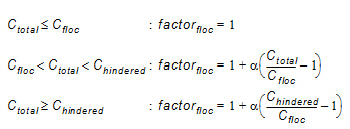
Flocculation is when the concentration of sediment is high enough for the sediment flocs to influence each other’s settling velocity. This happens because collisions between flocs will increase floc size leading to higher settling velocities.
In case of fine grained cohesive sediment (<0.006 mm), the size of the particles and thereby the settling velocity will depend on the rate of flocculation.
With low concentrations of suspended sediment, the probability for collision between the cohesive particles is low and the settling velocity will be close to the settling velocity for a single grain. With increasing concentration, collision between particles will occur more frequently and the cohesiveness of the particles will result in formation of flocs. This leads to an increase in average particle/floc size and with that an increase in settling velocity.
(5.4) 
(5.5) 
where
|
ws: |
Particle settling velocity |